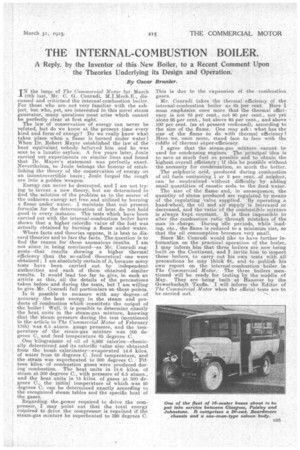THE INTERNAL-COMBUSTION BOILER.
Page 9

If you've noticed an error in this article please click here to report it so we can fix it.
A Reply, by the Inventor of this,New Boiler, to a Recent Comment Upon the Theories Underlying its Design and Operation.
By Oscar Brunkr.
IN the issue of The Commercial Motor for March 10th last, Mr. C. O. Conradi, M.I.Mecli.E., discussed and criticised the internal-cornbustion boiler. For those who are not very familiar with the subject, but who, yet, are interested in this novel steam generator, many questions must arise which cannot be perfectly clear at first sight.
The law of conservation of energy can never be refuted, but do we know at the present time every kind and form of energy ? Do we really know what takes place when a flame is burned under water? When Dr. Robert Mayer established the law of the heat equivalent nobody believed him and he was sent to a lunatic asylum. A few years later, Joule carried out experiments on similar lines and found that Dr. Mayer's statement was perfectly exact. Nevertheless, to Joule belongs the honour of establishing the theory of the conservation of energy on an incontrovertible basis ; Joule forged the rough ore into a golden weapon.
Energy can never be destroyed, and I am not try, ing to invent a new theory, but am determined to find the solution of the problem as to the source of the unknown energy set free and utilized by burning a flame under water. I maintain that our present formulm for the determination of heat do not hold good in every instance. The tests which have been carried out with the internal-combustion boiler have shown that a higher calorific value of the fuel was actually obtained by burning a flame under water.
Where facts and theories oppose, it is best to discard theories and to face the facts. The question is to find the reason for these anomalous results. I am not alone in being convinced—as Mr. Conradi suggests—that results showing a higher thermal efficiency than the so-called theoretical one were obtained ; I am absolutely certain of it, because many tests have been carried out by independent authorities and each of them obtained similar results. It would lead too far to give, in such an article as this, all the details of the precautions taken before and during the tests, but I am willing to give Mr. Conradi full particulars on these points.
Is it possible to measure with any degree. of accuracy the heat energy in the steam and products of combustion which constitute the output of the boiler? Well, it is possible to determine exactly the heat units in the steam-gas mixture, knowing that the )atearn pressure during the test (mentioned in the article in The Commercial Motor of February 17th) was 6.5 atmos. gauge pressure, and the temperature of the steam-gas mixture was 300 degrees C, and feed temperature 65 degrees C.
One kilogramme of oil of 8,662 calories—chemically determined and its calorific value also obtained from the bomb calorimeter—evaporated 14.6 kilos. of water from 65 degrees C. feed temperature, and the steam was superheated to 300 degrees C. Fifteen kilos. of combustion gases were produced during' combustion. The heat units in 14.6 kilos. of steam at 300 degrees C., with pressure of 6.5 atmos., and the heat units in 15 kilos. of gases at 300 degreea C., the initial temperature of which was 20 degrees C. can be determined exactly according to the recognized steam tables and the specific heat of the gases.
Regarding the power required to drive the compressor, I may point out that the total energy required to drive the compressor is regained if the steam-gas mixture be superheated to 320 degrees C. This Is due to the 'expansion of the combustion gases. Mr. Conradi takes the thermal efficiency of the internal-combustion boiler as 85 per cent. Here I must emphasize once more that the thermal efficiency is not 85 per cent., not 90 per cent., nor yet alone 95 per cent., but above 95 per cent., and above 100 per cent. (as at present reckoned), according to the size of the flame. One may ask ; what has the size of the flame to do with thermal efficiency Here we, once more, stand face to face with the riddle of thermal super-efficiency.
I agree that the steam-gas mixture cannot be used for condensing engines. The principal idea is to save as much fuel as possible and to obtain the highest overall effieiency; if this be possible without the necessity for condensation, so much the better.
The sulphuric acid, produced during combustion of oil fuels containing 1 or 2 per cent. of sulphur, can be neutralized without difficulty by adding small quantities of caustic soda to the feed water.
The size of the flame and, in consequence, the quantity of steam produced are regulated by means of the regulating •valve supplied. By operating a hand-wheel, the oil and air supply is increased or decreased, and the-ratio of the combustible mixture is always kept constant. It is thus impossible to alter the combustion ratio through mistakes of the man in charge. During idle periods, . while loading, etc., the flame is reduced to a minimum size, so that the oil consumption becomes very small.
Since Mr. Conradi would like to have further information on the practical operation of the boiler, I may inform him that three boilers are now being built on the Continent, and I invite him to inspect these boilers, to carry out his own tests with all precautions he may think fit, and to publish his own report on the internal-combustion boiler in The Commercial Motor. The three boilers mentioned will be ready for testing by the middle of May. They are being built at Hanover by the Gewerkschaft Taufla. I will inform the Editor of The Commercial Motor when the official tests are to be carried out.




























